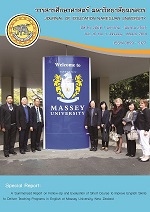การพัฒนากลยุทธ์การบริหารแบบดุลยภาพ (BSC) สำหรับสถานศึกษาขั้นพื้นฐาน
Main Article Content
Abstract
บทคัดย่อ
การวิจัยครั้งนี้เป็นการวิจัยแบบผสมผสานของการวิจัยเชิงปริมาณและการเก็บข้อมูลเชิงคุณภาพโดยมีวัตถุประสงค์ ดังนี้ 1) เพื่อศึกษาสภาพการบริหารงานของสถานศึกษาขั้นพื้นฐาน 2) เพื่อสร้างกลยุทธ์การบริหารแบบดุลยภาพ (BSC) สำหรับสถานศึกษาขั้นพื้นฐาน และ 3) เพื่อประเมินความเป็นไปได้ในการนำกลยุทธ์การบริหารแบบดุลยภาพ (BSC) ไปใช้ในสถานศึกษาขั้นพื้นฐาน
วิธีการวิจัยแบ่งเป็น 3 ขั้นตอน ดังนี้ ขั้นตอนที่ 1 ผู้วิจัยดำเนินการใน 3 ขั้นตอนย่อย คือ 1.1) ศึกษาจากสภาพการบริหารงานของสถานศึกษาขั้นพื้นฐานโดยการประยุกต์ใช้การประเมินดุลยภาพ (BSC) 4 มิติ คือ 1) ด้านผู้เรียน 2) ด้านการบริหารจัดการศึกษา 3) ด้านการเรียนรู้และพัฒนา และ 4) ด้านงบประมาณและทรัพยากรจากการสอบถามผู้บริหารสถานศึกษา ครูวิชาการจำนวน 758 คน และนักเรียน จำนวน 1,895 คน 1.2) ศึกษาและวิเคราะห์ข้อมูลผลการประเมินภายนอกรอบสองของ สมศ. ระหว่างปีการศึกษา 2549-2553 ของสถานศึกษาสังกัดสำนักงานคณะกรรมการการศึกษาขั้นพื้นฐานและรายงานการประเมินตนเองของสถานศึกษา (SAR) จำนวน 35 โรงเรียน 1.3) ศึกษากรณีศึกษาสถานศึกษาที่ประสบความสำเร็จ มีวิธีการปฏิบัติที่เป็นเลิศ (Best Practice) โดยการสัมภาษณ์ ผู้บริหารสถานศึกษา หัวหน้าฝ่ายงาน และประธานกรรมการสถานศึกษาขั้นพื้นฐาน สถานศึกษาละ 3 คน จำนวน 5 โรงเรียน รวมทั้งสิ้น 15 คน และศึกษาเอกสารเพิ่มเติม ได้แก่ แผนกลยุทธ์ รายงานการประเมินตนเองของสถานศึกษา (SAR) จากนั้นทำการวิเคราะห์ (SWOT Analysis) มีการเก็บรวบรวมข้อมูลโดยใช้แบบสอบถาม แบบสัมภาษณ์ วิเคราะห์ข้อมูลค่าสถิติพื้นฐานโดยใช้โปรแกรม SPSS และการวิเคราะห์เอกสารตามแบบที่ผู้วิจัยสร้างขึ้นการตรวจสอบร่างของการพัฒนากลยุทธ์แบบดุลยภาพ (BSC) สำหรับสถานศึกษาขั้นพื้นฐานโดยการสัมมนาอิงผู้ทรงคุณวุฒิ (Connoisseurship) ปรากฏผลการวิจัยดังนี้
1. ผลการศึกษาสภาพการบริหารสถานศึกษาขั้นพื้นฐาน พบว่า สภาพการบริหารของสถานศึกษาในภาพรวมทั้ง 4 ด้าน/มิติมีการปฏิบัติอยู่ในระดับมากเมื่อพิจารณาเป็นรายด้าน พบว่าด้านการบริหารจัดการศึกษาโรงเรียนมีการปฏิบัติมากที่สุด รองลงมาเป็นด้าน/มิติ งบประมาณและทรัพยากร ด้านผู้เรียน และด้านการเรียนรู้และพัฒนาซึ่งมีระดับการปฏิบัติที่ต่ำสุด นักเรียนมีความพึงพอใจต่อการบริหารสถานศึกษาอยู่ในระดับมาก
2. ผลการสร้างกลยุทธ์ได้กลยุทธ์การบริหารแบบดุลยภาพ (BSC) สำหรับสถานศึกษาขั้นพื้นฐาน ประกอบด้วย 4 ยุทธศาสตร์ ประกอบด้วย 10 กลยุทธ์หลัก 28 กลยุทธ์รอง 100 กลวิธี 109 ตัวชี้วัดดังนี้ 1) ด้านผู้เรียน: ประกอบด้วย 3 กลยุทธ์หลัก 9 กลยุทธ์รอง 33 กลวิธี 37 ตัวชี้วัด 2) ด้านการบริหารจัดการศึกษา ประกอบด้วย 2 กลยุทธ์หลัก 6 กลยุทธ์รอง 20 กลวิธี 21 ตัวชี้วัด 3) ด้านการเรียนรู้และพัฒนา ประกอบด้วย 3 กลยุทธ์หลัก 6 กลยุทธ์รอง 22 กลวิธี 24 ตัวชี้วัด 4) ด้านงบประมาณและ ทรัพยากรประกอบด้วย 3 กลยุทธ์หลัก 7 กลยุทธ์รอง 25 กลวิธี 27 ตัวชี้วัด
3. ผลการประเมินความเป็นไปได้ในการนำกลยุทธ์การบริหารแบบดุลยภาพ (BSC) สำหรับสถานศึกษาขั้นพื้นฐานพบว่า ผู้บริหารสถานศึกษา หัวหน้างาน ครูผู้สอน และประธานกรรมการสถานศึกษาขั้นพื้นฐานมีความเห็นว่ากลยุทธ์ กลวิธีและตัวชี้วัดสามารถนำไปใช้ในการบริหารสถานศึกษาได้ คือ มีระดับค่ามัธยฐาน (Mdn) อยู่ระหว่าง 4.50-5.00
คำสำคัญ: กลยุทธ์/ การบริหารแบบดุลยภาพ/ สถานศึกษาขั้นพื้นฐาน
Abstract
This mixed-method research applying both quantitative and qualitative approaches was aimed at 1) investigating the administrative conditions in primary schools, 2) developing the balanced scorecard (BSC) for primary schools, and 3) assessing the possibility of implementing BSC administrative strategies in primary schools.
The research procedure was divided into three phases as follows: 1) The researcher worked in three steps 1.1) studying the administrative conditions of primary schools by applying the BSC assessment in four dimensions: a) students, b) educational administration, c) learning and development, and d) budgets and resources, eliciting the data by asking 758 school administrators and academic teachers and 1,895 students, 1.2) studying and analyzing the second round of external assessment results by Office for National Education Standards and Quality Assessment (ONESQA) during 2006-2010 of schools under the jurisdiction of the Commission of Primary Education and self-assessment reports (SAR) of 35 schools, 1.3) studying five cases of successful, well-known, or quality schools (labeling “very good” in all education standards) by interviewing the total of 15 people consisting of the school administrator, a department chief, and the chair of the primary school committee of each school, studying additional documents including the schools’ strategic plan, their SAR, and their information, and then doing a SWOT analysis. The data were collected using a questionnaires and interviews. The statistical analysis was done by the SPSS programming and the documentary analysis designed by the researcher. The examination of the draft of the BSC strategic development by means of connoisseurship revealed the results as follows:
1. The result of investigating the administrative conditions of primary schools showed that the school administrators and the academic teachers thought that the overall administrative conditions of primary schools n all aspects/dimensions were at the “high” level, and when each aspect/dimension was considered, it was found that all aspects were at the “high” level. These can be arranged respectively as follows: 1) administration and management, 2) budgets and resources, 3) learners, and 4) learning and development. The students’ overall satisfaction with the administrative conditions of the primary schools was at the “high” level.”
2. The result of strategy development was the balanced scorecard (BSC) administrative strategies for primary schools, consisting of four strategic issues which consisted of 10 main strategies, 28 subordinate strategies, 100 tactics, and 109 key performance indicators (KPIs) as follows: 1) Strategic issue1 – Development of learner quality consisting of three main strategies, nine subordinate strategies, 33 tactics, and 37 KPIs; 2) Strategic issue 2 – Increase of efficiency in educational administration consisting of two main strategies, six subordinate strategies, 20 tactics, and 21 KPIs; 3) Strategic issue 3 – Development of the teachers’ and personnel’s capacity consisting of three main strategies, six subordinate strategies, 22 tactics, and 24 KPIs; 4) Strategic issue 4 – Collection of resources and budgets consisting of three main strategies, seven subordinate strategies, 25 tactics, and 27 KPIs;
3. As for the assessment of the possibility for implementing the BSC administrative strategies, it was found that school administrators, department chiefs, and chairs of primary school committees thought that these strategies, tactics, and KPIs could be implemented for school administration. The median was between 4.50 and 5.00.
Key words: Strategy/ Balanced Scorecard/ Primary Schools
Article Details
The owner of the article does not copy or violate any of its copyright. If any copyright infringement occurs or prosecution, in any case, the Editorial Board is not involved in all the rights to the owner of the article to be performed.


